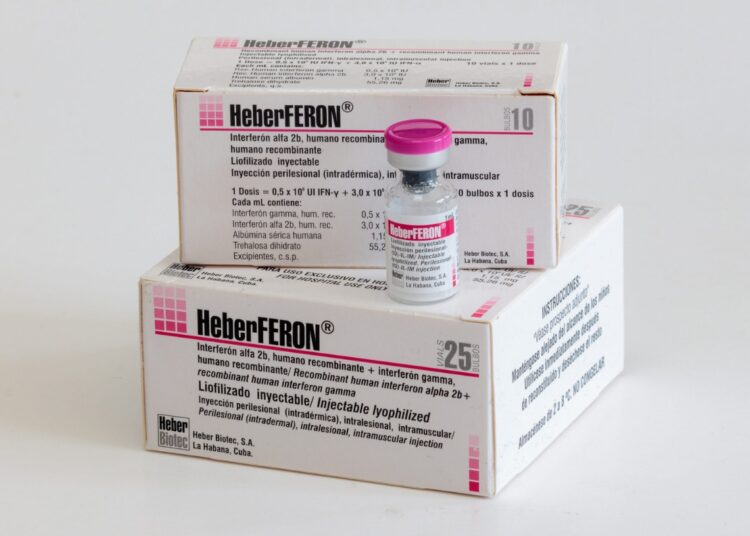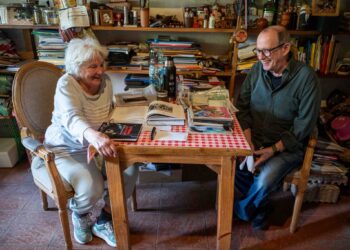The COVID-19 pandemic marked us all, especially those of us who were on the front line of the fight against the disease. We were faced with something that surpassed everything we had experienced personally and professionally until then. The magnitude of the enemy was made clear to us with the death of family members, acquaintances, and colleagues.
The most difficult thing in those circumstances was the lack of specific drugs to combat SARS-CoV-2. Having a vaccine seemed like something far away. Amid this confusion, we learned that Cuba had a drug capable of generating a positive impact in the fight against the disease: recombinant human interferon (IFN) alpha 2b.
I knew about IFNs because I studied them during my degree and even had to use them once, after a work accident. But it was not until the pandemic that I delved into the benefits of this pharmacological group, closely linked to a truly revolutionary topic in the field of medicine, immunotherapy, to which we dedicated an article in this column and which played a relevant role in the emergence of the Cuban biopharmaceutical industry.
Cuban drug HeberFeron: eight times more effective against skin cancer
The family of interferons (IFN)
According to an article published in the journal ScienceDirect in 2015, IFNs form a family. Its first members were discovered in 1957 by New Zealander Alick Isaacs and Swiss Jean Lindenmann. These researchers found that the cells they worked with when exposed to the influenza virus, secreted a substance that “interfered” — hence its name — in viral activity, generating strong immunity.
This and other studies laid the groundwork for what is now known as the IFN family, a set of proteins grouped into three types (I, II and III). Among their most important functions are: limiting the spread of viral infections, modulating immune system responses to prevent their effect from being harmful to the body, and generating an adaptive immune response, which includes elements such as immunological memory. This allows the body to recognize harmful agents and fight them, as in the case of chickenpox; once we are infected, we do not get it again. Finally, it was discovered that they had anti-proliferative activity, that is, they prevent cancer cells from multiplying, which supports their use in the treatment of different oncological diseases.
This group of substances was of capital importance in the emergence of Cuban biotechnology. In the early 1980s, a group of scientists from the island traveled to Finland, where Dr. Kari Cantell, in his laboratory at the National Institute of Health in Helsinki, had developed a method for obtaining leukocyte IFN. After their return, it took 58 days to produce the first batch of the product, according to a publication by the Center for Genetic Engineering and Biotechnology (CIGB) on May 28, 1981.
The drug was used, once validated by Dr. Cantell himself, during the dengue epidemic that devastated Cuba at that time. The second use of this drug was in 1981, when it was tested in the conjunctivitis epidemic that affected the country.
However, obtaining leukocyte interferon was cumbersome. It required dozens of blood donations to obtain a very limited amount of the product. The production process involved isolating the immune cells, which were then exposed to viral agents so that they would produce interferon naturally. The product obtained at this stage was not yet suitable for use in humans. It still had to go through a purification process.
In 1980, the German researcher Charles Weissman, from the University of Zurich, developed a method for obtaining recombinant human IFN. It consisted of using the genetic apparatus of bacteria as the factory for the product, after modifying their DNA for that purpose, that is, after providing them with “a human mold.” This procedure was introduced in our country in 1983 by the general physician, specialized in genetics, Dr. Luis Herrera.
Thanks to the combined effort of the researchers and the support of the island’s government, the Center for Genetic Engineering and Biotechnology (CIGB) was created in 1986. It had as its star products in those initial years different types of recombinant IFN. It can be said that the production of these drugs was the starting point for the development of the national biotechnology industry.
During the 40 years that followed that historic moment, millions of doses of nationally produced IFNs have been used on and off the island to combat various diseases, such as those caused by the human papillomavirus (HPV), hepatitis, dengue, HIV, etc. It has also been used in onco-hematological diseases, such as leukemia and lymphomas, and solid tumors of different locations. Finally, its use has been tested in neurological diseases such as multiple sclerosis.
The pandemic and the rebirth of IFN
Nearly 40 years after the production of the first interferons in Cuba, this pharmacological group gained relevance again during the early stages of the COVID-19 pandemic.
Chinese researchers studied the effect of Heberon®, one of the members of the interferon families, on the disease when there was still no useful medicine to treat it. In this context, various studies suggested that both alone and in combination, its use was associated with favorable results, such as reduced mortality when administered in the early stages of the disease.
This research was replicated in Cuba with similar results. A study carried out between March and April 2020 found, among its most relevant results, that the mortality rate in patients with COVID-19 was particularly lower in those receiving IFN and other medications when compared to other therapeutic regimens.
In these circumstances, the interest generated by Cuban Interferon alpha 2b was very high. In April 2020, it became known that more than 80 countries had shown interest in acquiring it. It was precisely at that time that the South African military bought the product, intending to immunologically reinforce soldiers during the first stage of the pandemic.
However, it was later discovered that SARS-CoV-2 was a germ capable of evading, in some people, the response induced by the IFNs produced by the body. Among the causes that explain this phenomenon are genetic conditions specific to each individual; the existence of anti-IFN antibodies, of particular relevance in patients with severe forms of COVID-19; a delay in the immune response induced by IFNs in respiratory cells and very complex mechanisms of cellular biology, according to the article “Interferon at the crossroads of SARS-CoV-2 infection and COVID-19 disease,” by Dr. Charles E. Samuels, from the Department of Molecular, Cellular and Developmental Biology at the University of California.
The above partly explains the lack of consistency in the results of the studies that were later carried out with different types of IFN for the treatment of COVID-19. This led to a decrease in interest in these products and, from subcutaneous forms of administration to nasal forms were used. An example is the well-known Cuban Nasalferon, which is nothing more than recombinant human IFN Alpha 2b in a nasal formulation. Tens of thousands of doses of this drug were administered in our country. However, nothing could prevent the pandemic peak in the summer of 2021 in Cuba.
A foundational and very useful product
On January 29, the South African media The Citizen revealed that in a committee of the parliament of that country, the Special Investigation Unit (SIU) had found irregularities in the acquisition of the Cuban drug Heberon® (recombinant human Interferon alpha 2b), during the pandemic. These involved an expense of more than 33 million rands (1.8 million USD).
The irregularities included that the purchase had not been made following a tender process, the Cuban medicine had not been approved by the South African regulatory agency (SAPHRA) nor was the purchase endorsed by the Secretary of Defense. In addition, the contract was signed once the medicines were already in the possession of the South African National Defense Forces.
The above is part of a scandal of corruption and widespread irregularities in the Department of Defense of that country, and has nothing to do with the usefulness of the interferon family, as some media have misleadingly pointed out.
Indeed, IFNs were not the miracle cure for cancer, as was thought more than forty years ago, when they began to be produced throughout the world, nor the panacea that defeated SARS-CoV-2. But no one can take away from them the credit for having saved, prolonged, or conferred quality of life to millions of people in the world over decades. Additionally, miracle cures are more a product of propaganda, politics, and marketing than of science, which naturally distrusts them.
On the other hand, interferons continue to be, according to the article by Dr. Samuels cited here, “the cornerstone” in the body’s antiviral response. The development of new medications and strategies to combat current and future diseases, such as the so-called disease X, will depend, in part, on a deep understanding of their mechanisms of action and the pathways used by viruses and cancer cells to evade them.
As for Cuba, its importance goes even further, since this family of drugs constitutes the foundation stone of an industry that generates jobs, quality products, and dividends for the country, in addition to its decisive impact on public health. This is no small feat for a pharmacological group discovered more than seventy years ago.










